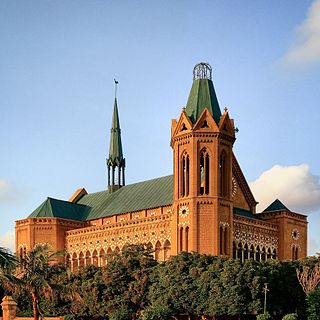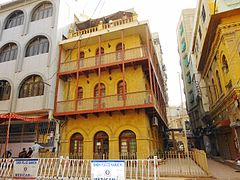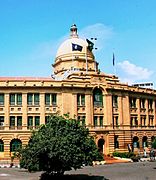
Jamatkhana or Jamat Khana is an amalgamation derived from the Arabic word jama‘a (gathering) and the Persian word khana. It is a term used by some Muslim communities around the world, particularly sufi ones, to a place of gathering. Among some communities of Muslims, the term is often used interchangeably with the Arabic word musallah. The Nizārī Ismā'īlī community uses the term Jama'at Khana to denote their places of worship.

Wazir Mansion, officially known as Quaid-e-Azam Birthplace Museum is a former family home in the Kharadar district South at Karachi, Sindh, Pakistan which is considered the birthplace of the country's founder, Muhammad Ali Jinnah.

Saddar, also known as Saddar Bazaar, is a neighbourhood in Karachi, Pakistan. The locality was developed as the primary commercial district during the period of British-era rule in Karachi. As a result, Saddar contains the large concentration of colonial-era architecture in Karachi.
Gulbahar or Gul Bahar is one of the neighborhoods of SITE Town in Karachi, Sindh, Pakistan.
SherShah is a neighbourhood in Karachi, Pakistan, that is located along the northern bank of the Lyari River. Sher Shah is home to the Morroro Graveyard - a vast cemetery that is centuries old. It is also the site of some of Karachi's recycling industry. In October 2010, Baloch terrorists gunned down 13 members of the Urdu-speaking community in a spare-parts market.

Allama Iqbal Colony is a residential neighbourhood in Lyari Town, located in the Karachi South district of Karachi, Pakistan.
Kala Board is a neighborhood in Karachi, Pakistan, that is within Malir District. The areas included in this Union Council are: from Kalaboard & Malir City 15 to A-area, B-area, Liaquat Market G-area, Muhabbat Nagar, Baraf Khana, Darakhshan Society, Al-Ameen Society, till Laal Masjid C-area.

New Karachi Town or North Karachi Town lies in the northern-eastern part of Nazimabad District, Sindh province of Pakistan. It was formed when katchi abadis were resettled following the 1958 coup d'état. Town system was established by City District Government Karachi in 2001. Town system was disbanded in 2011. New Karachi Town was re-organized as part of Karachi Central District in 2015. New Karachi Town has a population 1,166,742 as of 2023 Pakistani census.

Saddar Town lies in the Karachi District South that forms much of the historic colonial core of Karachi, in the Sindh province of Pakistan. According to the 2023 Pakistani census, Saddar Subdivision has a population 159,363.
Garden is an upmarket neighbourhood, which is in the Karachi South district of Karachi, Pakistan. It is subdivided into two neighborhoods: Garden East and Garden West. It is the residential area around the Karachi Zoological Gardens, hence it is popularly known as 'Garden' area. Garden East is home to a house of worship for Baháʼís. It is also location of the Cincinnatus Town neighborhood which was established by Goan Catholics. The main Karimabad Jamaat Khana is the largest Ismai'li house of worship in the world.

City Railway Colony is a neighbourhood in Saddar Town in Karachi, Pakistan, and is part of the administrative district Karachi South.

Civil Lines is an upmarket neighbourhood in Karachi, Pakistan that was where much of Karachi's British officials and local elite resided during the colonial era. Numerous buildings of architectural significance are located in the locality, including civic administration buildings, churches, mansions, and social clubs.
Mithadar is one of the neighbourhoods of Saddar Town in Karachi, Sindh, Pakistan, and comprises the oldest part of Karachi that was once encircled by a wall. Mithadar and the adjacent community of Kharadar together form what is regarded as the original core of Karachi.

Muhammad Ali Jinnah Road, frequently abbreviated as MA Jinnah Road, is a major thoroughfare in central Karachi, Pakistan. The road was originally named Bandar Road, because it linked the city to the Port of Karachi, but was later renamed in honour of Pakistan's founder, Muhammad Ali Jinnah. MA Jinnah Road stretches 6.1 kilometres from Jinnah Bridge in the south, near the Port of Karachi, to Gurumandir Chowk, north of Mazar-e-Quaid. It is one of the city's oldest roads, and passes through much of the colonial era historic core of Karachi, with numerous landmarks along its route.
Dhoraji Colony is a neighbourhood in Gulshan-e-Iqbal Town, Karachi, Sindh, Pakistan, which is located between UC-1 and UC-2. The demarcation separating the two Union Councils runs from the National Stadium Road, towards Selani Chowk, past ZVMG Rangoonwala Community Centre via Siraj-ud-Daula road.
Ghanchi Para is a neighbourhood in District South of Karachi, Pakistan. It previously used to be part of Saddar Town.
Hijrat Colony is one of the neighbourhoods of Lyari Town in Karachi, Sindh, Pakistan.

The demographic history of Karachi of Sindh, Pakistan. The city of Karachi grew from a small fishing village to a megacity in the last 175 years.

















